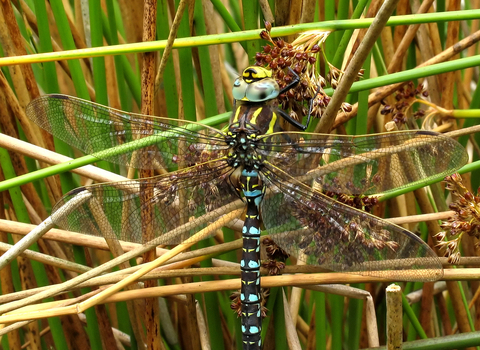
©David Kitching
©Claire Install
Common Hawker
A large hawker, the Common Hawker can be seen throughout the summer and into autumn. A fast-flying insect, it catches its prey mid-air. Look for it around ponds in the uplands of the north and west.
Scientific name
Aeshna junceaWhen to see
June to OctoberSpecies information
Category
Statistics
Length: 7.4cmCommon.
About
The Common Hawker is a large hawker dragonfly which is on the wing from the end of June through to October. It is a species found mainly in the uplands of the north and west, particularly moorland pools and lakes, as well as garden ponds. Hawkers are the largest and fastest flying dragonflies; they catch their insect-prey mid-air and can hover or fly backwards.How to identify
Mostly black in colour, the male Common Hawker has pale blue spots and yellow flecks all along the body, dark blue eyes, and pale yellow-and-blue patches on the thorax. The female has yellowish spots and brownish eyes. The black-and-blue hawkers are a tricky group of dragonflies to identify. The Common Hawker is larger and darker than the Migrant Hawker, lacks the lime green spots of the Southern Hawker, and has more black and less blue than the rare Azure Hawker of North Scotland.Distribution
Widespread, although mostly absent from South and East England.In our area
Common Hawker have been recorded across Montgomeryshire, but they are best looked for in moorland habitats. Look for them at our Glaslyn Nature Reserve.
Did you know?
A shy dragonfly, the Common Hawker is most often seen 'hawking' over its breeding areas looking for prey.Common Hawker have been recorded across Montgomeryshire, but they are best looked for in moorland habitats. Look for them at our Glaslyn Nature Reserve.
